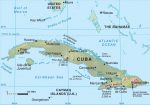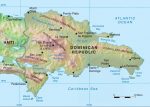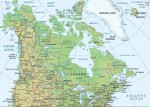
Physical Landscapes
Three major landform regions divide Chile: the Andes Mountains, the coast and islands, and the Central Valley. The regions run north to south and parallel to each other. The Andes region is an awesome mountain barrier. Its majestic peaks of spectacular height and bone-chilling temperatures define the country's eastern border. The nation's coast includes imposing […]

Physical Landscapes
Although we often speak of Cuba as one island, Cuba is actually an archipelago, or group of islands, whose total combined area is 42,803 square miles (110,860 square kilometers). Cuba is the largest island in this archipelago, making up 95 percent of the total land area of the island group. The second largest island, Isla […]

Physical Landscapes
The natural environment forms the foundation upon which all human societies depend for their survival. This is not to say that nature determines the way people live within a particular natural setting. To the contrary, a people's culture, or their way of life, is determined by human ingenuity—what they have learned and are able to […]

A Landscape of Sand
The great, flat sandy plains separating both the volcanic mountain ranges and the uplifted plateaus dominate most of the Arabian Desert. Covered with rocks or gravel fitted into something of an armor plating by the patient actions of wind and frost, these desert pavement surfaces protect the dry, sandy soil beneath. Some of the plains […]
Poland: Physical Landscapes
A country's physical environment can offer opportunities and challenges to its people. Poland's natural conditions are no exception. Nature provides the canvas upon which people paint their own unique cultural landscapes—the human imprint on Earth's surface. People are guided by their particular needs, as well as by the financial and technological resources they command. The […]
Ireland: Culture History and Cultural Landscape
Fado, fado, with the end of the Ice Age, 12,000 years ago, the glaciers retreated. They left Ireland covered with glacial debris and tundra vegetation. It was a barren land, with limited varieties of plant and animal life. This is the setting in which Ireland's changing culture history and cultural landscape takes place. Over the […]
Iceland: Landscapes of Fire and Ice
Iceland's physical geography can be summarized in three words: fire, ice, and sea. The island country rose from the sea as molten volcanic material. Today, approximately one-eighth of Iceland remains buried under glacial ice or permanent snow cover, but volcanic activity continues to be an omnipresent threat to the island's people and property. As in […]
Germany: Physical Landscapes
Germany has an area of 137,847 square miles (357,021 square kilometers). It stretches about 520 miles (840 kilometers) north to south, reaching from 47 to 55 degrees north latitude, and 385 miles (620 kilometers) east to west, between 6 and 15 degrees east longitude. The terrain can be divided into three regions that increase in […]

Belgium: Physical Landscapes
Belgium has a land area of 11,787 square miles (30,528 square kilometers), which, as already has been noted, is roughly equivalent in size to Maryland. Most of the country's territory lies on a huge lowland plain that stretches from the Pyrenees eastward to the Urals. In this chapter, we will look at Belgium's land areas, […]

Canada: Physical Landscapes
Canada is a vast country with a great variety of impressive scenery. The natural environment, or physical landscape, provides the stage upon which human cultures play out their ways of living. In this regard, Canada is blessed in countless ways—its land regions, weather and climate, ecosystems, water features, and other natural resources offer much diversity […]
Natural Environments and Landscapes
France possesses a varied and productive physical environment. In this chapter, you will learn about the country's diverse land features, climates, soils, wild vegetation, and mineral resources. LANDFORMS Although considered a lowland country, France's physical geography is, in fact, extremely varied, ranging from high, rugged mountains to low-lying sandy coastal plains. Running northward and eastward through France is a major drainage […]

Fluvial Landscapes
GREAT WATERFALLS Large waterfalls are comparatively rare the world over, since the stream gradation process drains lakes and removes falls and rapids. But when tectonic activity fractures and dislocates crustal blocks, erosion may be hard pressed to keep up. As a result, we see great waterfalls on several large rivers in the African Rift Valley region. One of these is Victoria […]